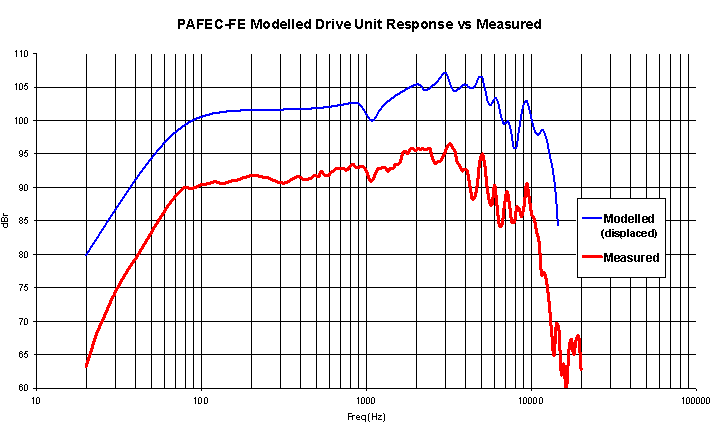
Goodman's test drive unit - comparison of PAFEC results with experimental results |
|
|
|
 |
|
|
|
Traditional loudspeaker design involves the use of equivalent circuits; a technique that assumes that the performance of loudspeakers can be characterised entirely by an analogous electrical circuit. The applicability of this technique is restricted to low frequencies where the loudspeaker moves as a rigid piston. At higher frequencies, the loudspeaker behaves as a complicated resonant system and a different analysis technique is required. |
| |
|
PAFEC is a continually developing suite of programs for applying Finite Element calculations to numerous experimental scenarios of interest to loudspeaker design engineers. I began working with PAFEC to address problems associated with the complex Vibroacoustic behaviour of loudspeakers. Responding to continuing customer demands for specific performance characteristics such as smoother, or more extended loudspeaker frequency responses by physically prototyping becomes an arduous, time consuming and expensive task. |
| |
|
PAFEC provides a more intelligent solution, a platform for virtually prototyping loudspeakers. Typically, a base model is developed that accurately represents the physical part under investigation. Changes to the model may then be applied, for example, geometry variations or material properties can represent interchanging components. The effects of these changes can be observed in a number of ways such as structural animations and frequency response curves as indicated in the associated web pages. |
| |
|
The animations illustrate the resonant structural behaviour observed in a typical loudspeaker drive unit as it is harmonically excited at a number of frequencies above the "pistonic" operating region. Comparing the animated results from PAFEC to the measured structural response using a Laser Doppler Vibrometer demonstrates the agreement between the real and virtual systems. Reference to the frequency response plot reveals the effects of these individual modes on the acoustic performance. |
| |
|
The acoustical domain is described using acoustic boundary element patches that interface with the structural model to produce a fully coupled analysis. Experience has shown that the ability to model the effect of the fluid on the lightweight structures under investigation is an important feature of the software. |
| |
|
The action of producing simulations of loudspeakers is an intense learning opportunity because the engineer is in control of most of the experimental variables. Often the reasons for non-convergence with measured data is because there are aspects of the loudspeaker, measurement or modelling process that are not fully understood and requires further investigation. |
| |
|
My experiences with PAFEC have helped to remove the "black art" from loudspeaker design. Long held suspicions regarding the causes of certain aspects of loudspeaker performance can be readily validated using PAFEC, which has afforded the Goodmans engineering team an insight into the complexities of high frequency loudspeaker performance. |
|
|
Kelvin Griffiths BEng(Hons) MIOA |
|
|
Research Engineer | |
|
Goodmans Loudspeakers Limited |
|
|
|
|
| Main audio page | Next |